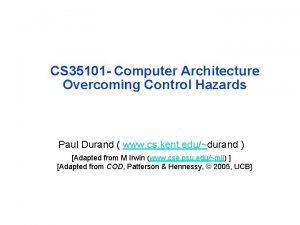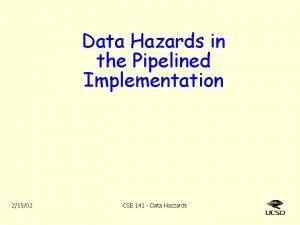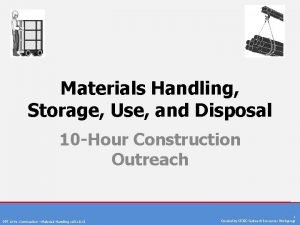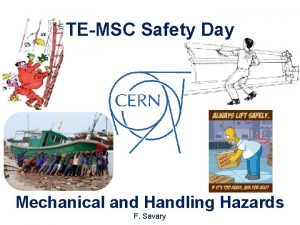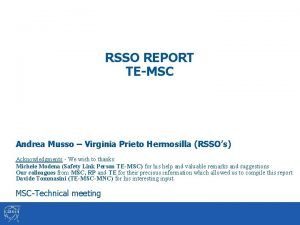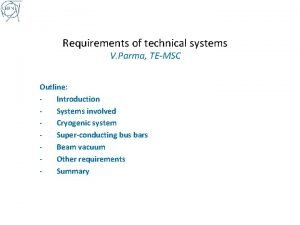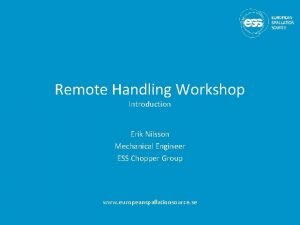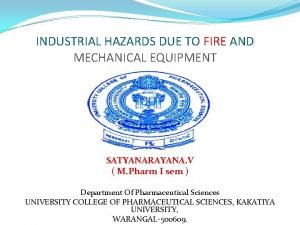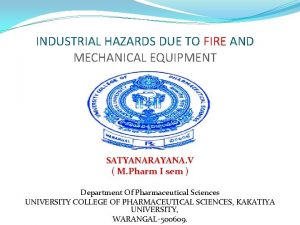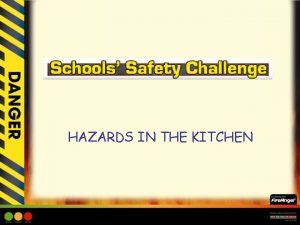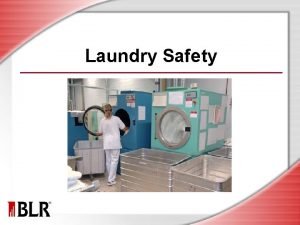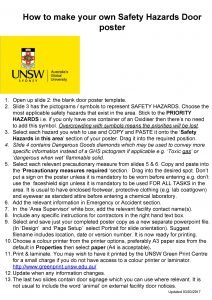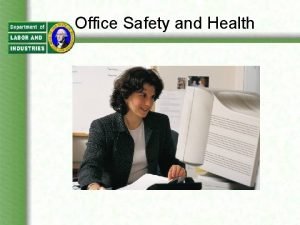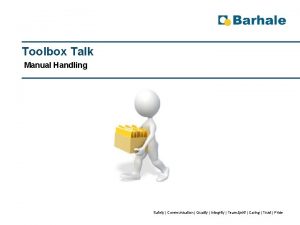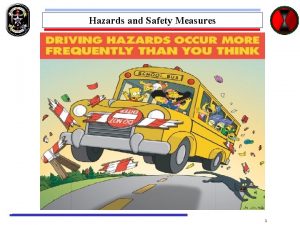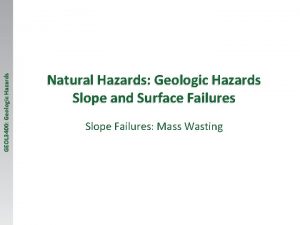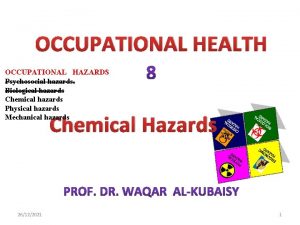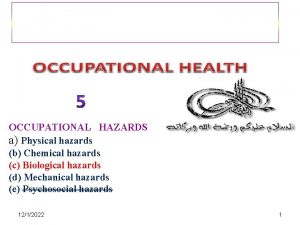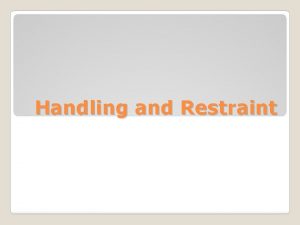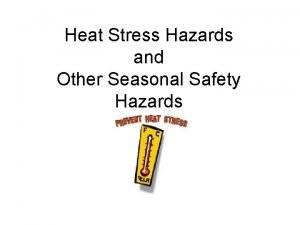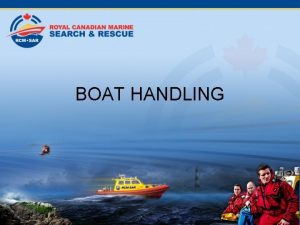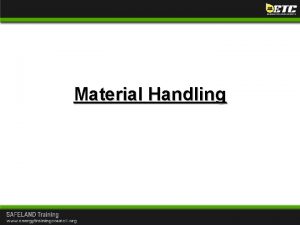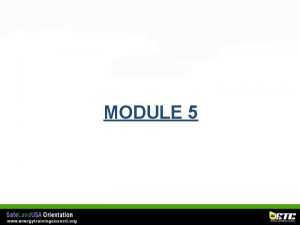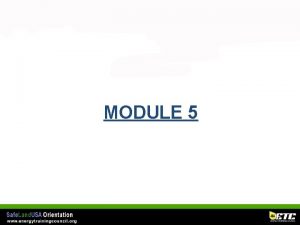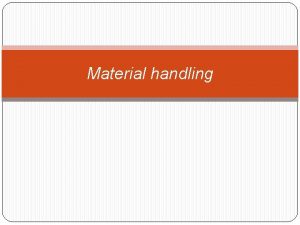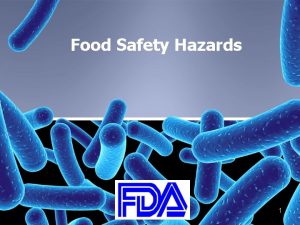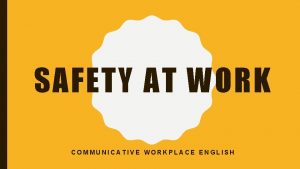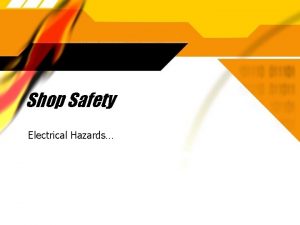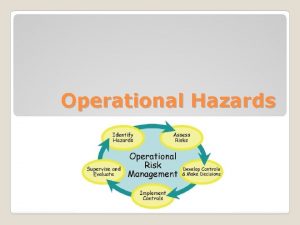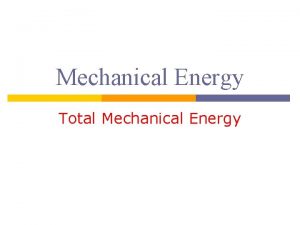TEMSC Safety Day Mechanical and Handling Hazards F





























- Slides: 29

TE-MSC Safety Day Mechanical and Handling Hazards F. Savary

Part I: Mechanical hazards 18/9/2014 Mechanical and Handling Hazards 2

Definition • • • A mechanical hazard is any hazard involving a machine or process Are essentially due to machine, components of the machine, moving parts of the machine, or any other source, which can injure a person Compressed gases or liquids can also be considered a mechanical hazard Types of mechanical injuries Cut Puncture Laceration Crush Bruises Bone Hematomas 18/9/2014 Mechanical and Handling Hazards 3

Machining* operations *Or more generally, operations on/with machinery/tools Conventional and CNC machine tools … but also folding presses, rolling machines, and cabling machines are other types • There are more special machines, e. g. M-line orbital cutting machines (LS 1) and bus bar surfacing, grinding machines, sawing, … • Against metal chips, burrs, powders, lubricants, cleaning agents, solvents: • • Goggles, gloves 18/9/2014 Mechanical and Handling Hazards 4

Some materials are more aggressive Fiberglass and composite materials require particular precautions • Always wear respirator/face mask, and goggles • Many resins are inflammable or contain additives that are inflammable, so be careful with heat sources • Many materials used in fiberglass work are corrosive, or have some undesirable effect on the skin (irritant), so protect your skin/eyes … again goggles and gloves! • 18/9/2014 Mechanical and Handling Hazards 5

Heavy loads may fall on the floor! • … and worst, on your foot! 18/9/2014 Mechanical and Handling Hazards 6

Welding, soldering, brazing • Personal protection (the welder) • • Protection of personnel working at the vicinity of a welding area (not the welder) • • Burns (adapted cloth, gloves), arc flash - “coup d’arc” (protect your face/eyes with a welding mask) Use curtains to surround the welding area Soldering, e. g. when using tin lead alloy (soldering of the shunts) • Analyses of fumes, in collaboration with HSE, have shown no trace of Pb, i. e. no need of a specific filter for this. However, a filter was used to prevent other hazards due to traces of rosin and alcohol 18/9/2014 Mechanical and Handling Hazards 7

Welding press for dipole shells, 1 On top of obvious welding related hazards • Mechanical hazards due to the necessity for the welder to watch carefully the weld pool during welding, … in a small space • 18/9/2014 Mechanical and Handling Hazards 8

Welding press for dipole shells, 2 emergency cable pull switch Help is recommended in certain circumstances … allocate sufficient resources 18/9/2014 Mechanical and Handling Hazards 9

Hydraulic and pneumatic systems, 1 Collaring press: Up to 375 MN over 15 m! High pressure up to 700 bar Hydraulic group of the welding press: Up to 162 MN over 16 m High pressure up to 550 bar 18/9/2014 Mechanical and Handling Hazards 10

Hydraulic and pneumatic systems, 2 • High pressure fluids hazards, hydraulically and pneumatically driven tools hazards • Crushing, high pressure / hot fluid leaks / jets 18/9/2014 • High pressure oil easily punctures skin causing serious injury, gangrene or death • If injured, seek emergency medical help. Immediate surgery is required to remove oil • Do not use finger or skin to check for leaks • Lower load or relieve hydraulic pressure before loosening fittings Mechanical and Handling Hazards 11

Real case: pressure test • • • When: March 2007 Where: LHC tunnel Need: verify/accept triplets after installation in the tunnel Action: carry out pressure test Incident: due to movement of one of the cold masses, rupture of a helium piping with strong detonation Consequence: 2 of the 7 persons who witnessed the test (even if at 25 m of the incident) presented signs of hearing loss (that disappeared after some time). Only one of the seven was wearing hearing protection 18/9/2014 Mechanical and Handling Hazards 12

• • • Machine conformity – Mise en conformité des machines To be checked with EN-MME, Emmanuel Ravry / Alain Stalder Safety Form M-4 -0 -2 - Workshop machine tool - Authorization of use 18/9/2014 Mechanical and Handling Hazards 13

For new and special machines • • • For example, a 6. 5 m long reaction furnace currently in assembly in B 180 Risk assessment file shall be developed by the manufacturer There are guidelines available at: https: //edms. cern. ch/document/1114042/3: Safety Guideline on risk assessment • https: //edms. cern. ch/document/1114759/3: Safety Tool for risk assessment • https: //edms. cern. ch/document/1218312/1: List of generic hazards typically present in workshops • 18/9/2014 Mechanical and Handling Hazards 14

Safety form – Risk assessment form 18/9/2014 Mechanical and Handling Hazards 15

See next presentation by John Pedersen 18/9/2014 Mechanical and Handling Hazards 16

Part II: Handling hazards 18/9/2014 Mechanical and Handling Hazards 17

Definition • • Manual handling of loads (MHL) and manual material handling (MMH) involve the use of the human body to lift, lower, fill, empty, or carry loads When performed incorrectly or excessively, these tasks may expose workers to physical risk factors, fatigue, and injury A variety of MMH techniques and tools exist to alleviate these potential problems Forklifts, overhead cranes, lifting girders, Span. Set® slings, … 18/9/2014 Mechanical and Handling Hazards 18

Manual handling and lifting • There are legal limits, depending on the age/sex, but also the distance and the characteristics of the task (articles R. 4541 -1 à R. 4541 -9 du code du travail, norme AFNOR X 35 -109 et décret n° 92 -958 du 3 septembre 1992) • Boys • From age 14 to 15: 15 kg • From age 16 to 17: 20 kg • Men • Max 55 kg • May be allowed to carry loads above 55 kg, if recognized able to do so by the occupational physician • In any case the load shall not exceed 105 kg. Article R. 231 -72 of «code du travail» says: «Lorsque le recours à la manutention manuelle est inévitable, et que les aides mécaniques ne peuvent pas être mises en oeuvre, un travailleur ne peut être admis à porter d’une façon habituelle des charges supérieures à 55 kgs, qu’à condition d’y avoir été reconnu apte par le médecin du travail, sans que ces charges puissent être supérieures à 105 kgs» 18/9/2014 Mechanical and Handling Hazards 19

Recommendations for manual handling of loads 18/9/2014 Mechanical and Handling Hazards 20

Real case: bus bars in ISR • • • When: March 2012 Need: remove 16 -m long bus bars from storage in the ISR (B 181) Action: 3 persons intervene, one of them climb on wooden crates to reach the bb stored in height Accident: a person falls down between crates Safety rules for work in height were somehow neglected Consequence: the person was absent for 7 weeks 18/9/2014 Mechanical and Handling Hazards 21

Heavy Handling 18/9/2014 Mechanical and Handling Hazards 22

Heavy Handling Section – EN-HE-HH http: //en-dep. web. cern. ch/endep/Groups/HE/Sections/HH/he_hh_mandate. ht m • In principle, any overhead crane is driven by a professional from EN-HE-HH • However, a specific training course “pontierélingueur” is available and allows using overhead cranes of up to 20 t • Authorizations to operate a crane are given exclusively by the EN-HE Group Leader, CERNwide, for a specific crane (we do not get authorization for any crane on the CERN site) • 18/9/2014 Mechanical and Handling Hazards 23

Design/use of handling tools/girders • May not be used if not formally approved by HSE • CE conformity required • Load test needed • Design work may be done on our side; however, one needs to follow codes and norms in force for handling/lifting equipment • Again, support from HSE is possible 18/9/2014 Mechanical and Handling Hazards 24

Norms regarding lifting / handling 18/9/2014 Mechanical and Handling Hazards 25

Some concluding words … 18/9/2014 Mechanical and Handling Hazards 26

Put priorities in the right order! No room for procrastination* in safety • Safety first, remember the ranking put in force for LS 1: Your • 1. SAFETY 2. QUALITY 3. SCHEDULE 4. COST • *Procrastination: , h t l a , y he t i r g e t n i l a c i s y h p life ! d e n r e c n o c are • The action of delaying or postponing something • The practice of carrying out less urgent tasks in preference to more urgent ones, or doing more pleasurable things in place of less pleasurable ones, and thus putting off impending tasks to a later time 18/9/2014 Mechanical and Handling Hazards 27

Things to remember Act as a professional, qualification and training are essential to ensure safety at the workplace • Do not improvise if you are not sure of what you do (or are asked to do), always ask to experienced staff in case of doubt • Safety is the matter of all • You can always talk to your supervisor, section leader, group leader, Territorial Safety Officer, Departmental Safety Officer (Thomas Otto) • 18/9/2014 Mechanical and Handling Hazards 28

Useful links • HSE: Occupational Health and Safety and Environmental Protection Unit • https: //espace. cern. ch/hse- unit/en/Pages/Safetyin. Departments. aspx • In particular safety rules https: //espace. cern. ch/Safety-Rules -Regulations/en/Pages/default. aspx, and • Regulatory watch that provides you with a list of referenced documents (laws, standards, guides, . . . ) applicable in matters of Safety: https: //espace. cern. ch/Safety-Rules. Regulations/en/regulatorywatch/Pages/regul. Watch. aspx • Call them in case of doubt • Departmental safety plan – TE • http: //safety-commission. web. cern. ch/safety- commission/Safety. Plan/te/e_index. htm 18/9/2014 Mechanical and Handling Hazards 29
 Day 1 day 2 day 3 day 4
Day 1 day 2 day 3 day 4 Handling control hazards in computer architecture
Handling control hazards in computer architecture Handling data hazards
Handling data hazards A way to prevent materials handling hazards is to ___.
A way to prevent materials handling hazards is to ___. Handling
Handling Temsc
Temsc Andrea musso
Andrea musso Temsc
Temsc Hfm assessment
Hfm assessment Day 1 day 2 day 817
Day 1 day 2 day 817 Mechanical and remote handling
Mechanical and remote handling Fire hazards in pharmaceutical industry
Fire hazards in pharmaceutical industry Mechanical hazards in industry
Mechanical hazards in industry Kitchen hazards picture
Kitchen hazards picture Mechanical energy hazards
Mechanical energy hazards Laundry objectives
Laundry objectives Door hazard
Door hazard Hazard
Hazard Communication toolbox talk
Communication toolbox talk Actual mechanical advantage vs ideal mechanical advantage
Actual mechanical advantage vs ideal mechanical advantage Wilt thou be gone it is not yet near day
Wilt thou be gone it is not yet near day Family portal schoolmax
Family portal schoolmax Oceans apart day after
Oceans apart day after Day to day maintenance
Day to day maintenance Physical science chapter 6 review answers
Physical science chapter 6 review answers I don't know tomorrow
I don't know tomorrow Growing day by day
Growing day by day Observation of seed germination day by day
Observation of seed germination day by day Conclusion of seed germination
Conclusion of seed germination Seeds vs spores
Seeds vs spores

